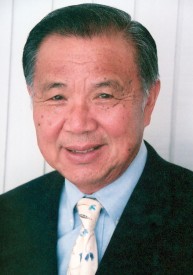You are looking at an archived version of our site. Please visit thepcc.org for a fresh, new experience!
Calvin Sia
Calvin C.J. Sia, MD, FAAP is considered the “grandfather” of the medical home concept of care. He has been a tireless child advocate in Hawaii, nationally and internationally.
As a primary care pediatrician in solo and two-person practices in Honolulu, he recognized early in his career the importance of accessible, family centered, coordinated, comprehensive, continuous, and culturally effective care for patients in his practice. He became an advocate for programs for all children—especially those with special health care needs—that focused on developing the medical home system of care beginning in early childhood.
He was among the early cadre of AAP pediatric consultants for Head Start and Parent Child Centers in Hawaii in the 1960s and he helped established the Variety School for Learning Disabilities in 1967. In 1970, he helped develop the Child Protection Crisis Center at the Children’s Hospital in Hawaii and the home visiting program to prevent child abuse and neglect in Hawaii. He also planned and implemented a statewide School Health System with special education services in 1970 in Hawaii and voluntarily chaired an Interagency School Health Planning Group that met monthly for 20 years.
In 1978, he brought together representatives from the Hawaii AAP Chapter, the University of Hawaii School of Medicine, the Hawaii Medical Association, and Kapiolani Medical Center for Women and Children to develop a Child Health Plan for Hawaii. This was the birth of the medical home concept for primary care—“Every Child Deserves a Medical Home”—with family centered, community based (geographically and financially accessible), coordinated, comprehensive, and continuity of care. The major emphasis of Hawaii’s plan was prevention and early intervention in early childhood.
Since there was a push for change nationally in the 1980s with the evolution of the Title V Maternal and Maternal and Child Health Bureau (MCHB) programs (e.g., State Block Grant funding, implementation of Medicaid/EPSDT, and Education for Handicapped Children (IDEA) Part C for Zero to Three programs), various approaches were attempted to improve care coordination for children with special health care needs.
In 1984 in Hawaii Dr. Sia began to implement the medical home concept beginning with the Hawaii Healthy Start Home Visiting Program for the prevention of child abuse and neglect. On a national level, the following year, he was successful in working with Senator Daniel Inouye to enact a National Emergency Medical Services for Children System (EMSC) demonstration grant program to address acute injuries, illnesses, and other childhood crises. States receiving these demonstration grants established an emergency medical care service system for children. Hawaii received one of these early grants to initiate its own emergency care system for children that related to the medical home. EMSC is now an established statewide system of care for children in all 50 states and territories.
In the same year, the Hawaii Medical Association was awarded a grant from MCHB, under the Special Projects of Regional and National Significance (SPRANS) initiative, to train primary care physicians to become a medical home for all children with special health care needs.
Finally, in 1986, the Hawaii Early Intervention Program for infants and toddlers was launched and Dr. Sia was active on the first Hawaii Early Intervention Coordinating Council for Zero to Three in Hawaii’s Department of Health. The focus of this effort was to support the medical home system of care with prevention and early intervention programs, especially for children with special health care needs.
From the early 1990s, Dr. Sia focused on implementing family-centered medical home as a comprehensive system of care for early childhood. As Principal Investigator, he was involved with several initiatives including a MCHB Health Education Collaboration, Carnegie’s Starting Point, and Consuelo Foundation of Hawaii’s Healthy and Ready to Learn grants – all with the emphasis on integrating the continuum of care of the medical home with other health, family, and community services from a holistic approach.
This past decade, he has expanded his efforts related to early child development and the medical home to the Far East, originally with APRICA/Japan, and with selected pediatric and early childhood professionals from China—Beijing, Shanghai, Hong Kong, Philippines, Singapore, Thailand—and the United States. Since 2003, five conferences have been held nationally and internationally that have stimulated translation of the science on early child development and primary care to advocacy, service delivery, research, and training among the Asian early childhood professionals leadership.
Dr. Sia has served as president to the Hawaii Chapter of the American Academy of Pediatrics (AAP), President of Hawaii Medical Association (HMA), and a member of AAP Committee on School Health, Pediatric Emergency Medicine, District VIII CATCH Facilitator, and other AAP Ad Hoc Committees. He is currently the chairperson of the Medical Home Implementation Project Advisory Committee (MHI-PAC) to the National Center for Medical Home Implementation, Immediate Past chairperson of the AAP Delegation to the American Medical Association (AMA) House and chairperson of the Section Council on Pediatrics, and past chairperson of National Dyson Initiatives Advisory Committee for Pediatric Residency Training in Community Pediatrics. He has served as a member of National Institute of Child Health and Human Development Advisory Council and Advisory Commission on Childhood Vaccines, HHS and American Board of Pediatrics, Oral Examiner. He has been a Clinical Professor of Pediatrics at the University of Hawaii, School of Medicine, until retirement from his almost 40 years of practice and as a Professor of Pediatrics in semi-retirement.
Dr. Sia has been blessed with a most supportive wife, Kathie, of 64 years. Over the years, they have enjoyed travelling and seeing different parts of the world on over 35 cruises. They have three sons, and six grandchildren.
For more information on medical home and the National Center for Medical Home Implementation, go to www.medicalhomeinfo.org.
Authorship and News Mentions
Settembre 1, 2020 - News - American Academy of Pediatrics
Maggio 14, 2015 - News - Patient-Centered Primary Care Collaborative
Menu secondario
Copyright © 2024 Primary Care Collaborative




